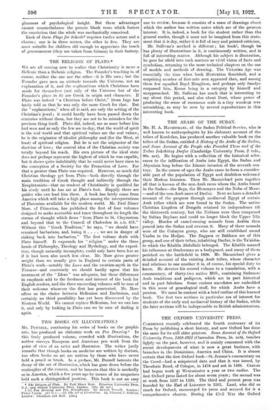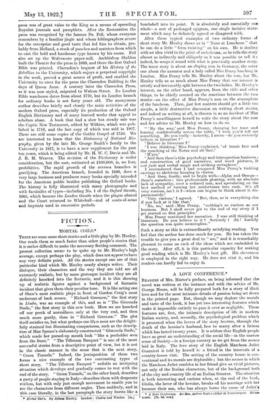THE OXFORD UNIVERSITY PRESS.
CAMBRIDGE recently celebrated the fourth centenary of its Press by publishing a short history, and now Oxford has done the same for its still older printers. Some Account of the Oxford University Press, 1468-1921 (Clarendon Press, 5s. net), touches lightly on the past, however, and is mainly concerned with the recent developments of what is now a great business, with branches in the Dominions, America and China. It is almost certain that the first Oxford book—St. Jerome's commentary on the Creed—had a misprinted date and that it was issued, by 'Theodoric Rood, of Cologne, in 1478 and not in 1468. Caxton had begun work at Westminster a year or two earlier. The first Oxford press fasted for about seven years ; the second was at work from 1517 to 1520. The third and present press was founded by the Earl of Leicester in 1585. Laud, who did so much for Oxford, encouraged its press and secured for it a comprehensive charter. During the Civil War the Oxford press was of great value to the King as a means of spreading Royalist journals and pamphlets. After the Restoration the press was recognized by the famous Dr. Fell, whom everyone remembers by a familiar jingle and whom bibliographers revere for the enterprise and good taste that led him to obtain, pro- bably from Holland, a stock of punches and matrices from which to cast the bold and handsome type known by his name. Fell also set up the Wolvercote paper-mill. Archbishop Sheldon built the Theatre for the press in 1669, and there the first Oxford Bible was printed. Clarendon's bequest of his History of the Rebellion to the University, which enjoys a perpetual copyright in the work, proved a great source of profit, and enabled the University to erect for the press the Clarendon Building in the days of Queen Anne. A century later the Clarendon Press, as it was now styled, migrated to Walton Street. Its London Bible warehouse dates from about 1770, but its London branch for ordinary books is not forty years old. The anonymous author describes briefly and clearly the main activities of the modern Oxford press, especially its production of the Oxford English Dictionary and of many learned works that appeal to scholars alone. A book that had a slow but steady sale was the Coptic New Testament, edited by Wilkins, which was pub- lished in 1716, and the last copy of which was sold in 1907. There are still some copies of the Gothic Gospel of 1750. We are interested to learn that the Dictionary of National Bio- graphy, given by the late Mr. George Smith's family to the University in 1917, is to have a new supplement for the past ten years, which is being edited by Mr. H. W. C. Davis and Mr. J. R. H. Weaver. The revision of the Dictionary is under consideration, but the cost, estimated at £100,000, is, we fear, prohibitive. The rapid growth of the oversea branches is gratifying. The American branch, founded in 1898, does a very large business and produces many books specially intended for the American public besides publishing the Oxford books. The history is fully illustrated with many photographs and with facsimiles of types—including No. 1 of the Oxford Gazette, 1665, which became the London Gazette when the plague abated and the Court returned to Whitehall—and of coats-of-arms and imprints used in successive periods.



































 Previous page
Previous page